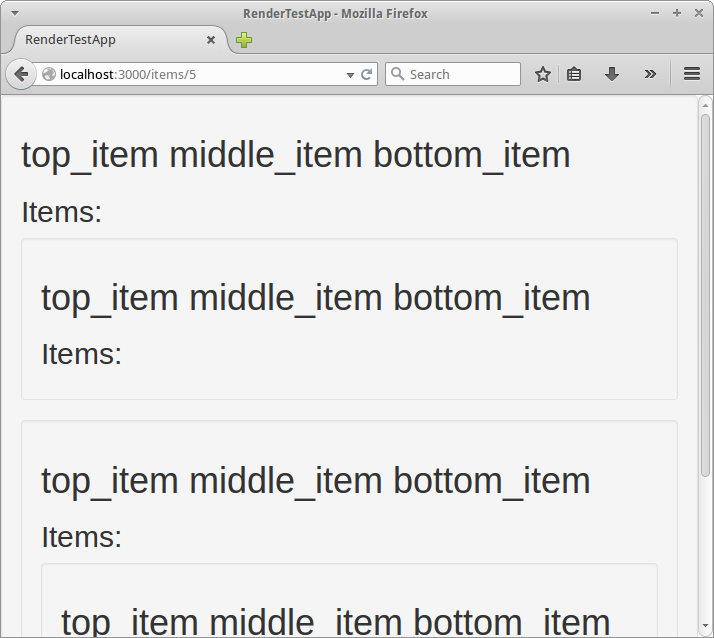So, gather around and I will tell you a story of a terrible curse. Or not:
###TL;DR
Add this to your application helper and use it instead of render whenever there’s a chance you will call a partial and try to wrap it in a layout.
def inside(options)
parent_view_flow = view_flow
self.view_flow = ActionView::OutputFlow.new
yield
output = render options
self.view_flow = parent_view_flow
output
endTakes the current view_flow, stores it, starts a new one, renders your partial, then puts everything back the way it was

###Layouts and Partials
Normally, it’s not so hard to apply a layout to a partial. Why would I apply a layout to a partial ? Am I nuts ? Possibly. Let me explain. Let’s say I have a bunch of things I would like to have similarly formatted = Use case for a layout. Say, you were trying to display something that was self-referencing. Like an Item that has_many items. Yes, that sounds reasonable. The Item object has a ‘name’ property.
rails g scaffold Item name item:references
Now, I warn you, I like haml with a bit o Bootstrap. So that’s how this is going to go down. Let’s say I have a template thus, for rendering one of these thingies and it’s children.
shared/_data_card.html.haml
.well
.h1
= content_for :name
.h2
Items:
= content_for :contentsAnd a partial for rendering an Item
item/_item.html.haml
-content_for :name do
= item.name
-content_for :contents do
= render item.items # this is where it's all going to go horribly wrong
=render partial: 'shared/data_card'A model.
models/item.rb
class Item < ActiveRecord::Base
belongs_to :item
has_many :items
endA bit of a tweak to
views/items/show.rb
=render @itemA little prep in rails console or migrations, whatevs.
Item.create(name: 'bottom_item', item: Item.create(name: 'middle_item', item: Item.create(name: 'top_item')))Probably need to work on making these names a bit less ‘itemy’
Rails is smart enough to work out what to do at render folder.contents. It’s going to render a collection, calling the folders/_folder partial for each Folder in contents. There is another way to do this. I could call
render partial: 'folder/_folder', layout: 'shared/filesystem_object'
instead. The results would be the same - bitterly disappointing.
Let’s take a look at some screenshots.

Well, that’s what we were HOPING for. But actually this is what you end up with:

WTF ?
Let me tell you WTF. It’s pretty simple. Rails has a thing called view_flow which is an instance of ActionView::OutputFlow. When you do content_for it puts the result of that block into the view_flow.content hash. If content_for gets called multiple times it concatenates the results. Are you feeling me ? So what happens in our example. Well, the following happens:
content_forfirst item’s :name is called.content_forfirst item’s content is called BUT it has to do this first:content_forsecond item’s :name is called (uh oh. what’s in theview_flownow ?)content_forsecond_item’s :content is called BUT it has to do this first: (oh dear lord)- etc…
- render all the crap above that’s been mashed together
- render all the crap AGAIN
You get the picture…
So get on with it already.
def inside(options)
parent_view_flow = view_flow
self.view_flow = ActionView::OutputFlow.new
yield
output = render options
self.view_flow = parent_view_flow
output
endThis little fella takes a copy of the view_flow and makes a fresh one for your recursive call, and puts it back once the result is computed and output. That stops stuff falling all over itself. How do we use it ? Easy. Let’s refer back to this partial:
item/_item.html.haml
= inside(partial: 'layouts/data_card') do
-content_for :name do
= item.name
-content_for :contents do
= render item.items # this is where it's all going to go swimmingly.view_flow feels horribly like a global variable, doesn’t it ? Perhaps there’s a way to make it local-er.
Thanks to André Arko for the inspiration for this solution. His solution doesn’t work for multiple content_for sections, but rather has a single yield. This didn’t work for my needs. His explanation helped me work out a refinement of his solution. Also, the format of his article inspired the structure of this one. So, many thanks.